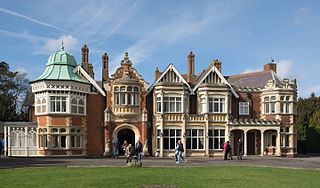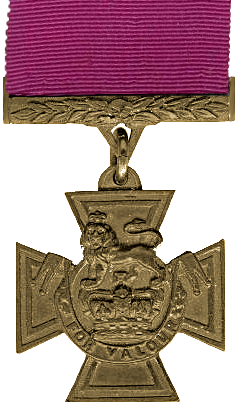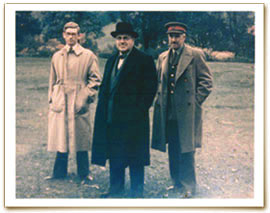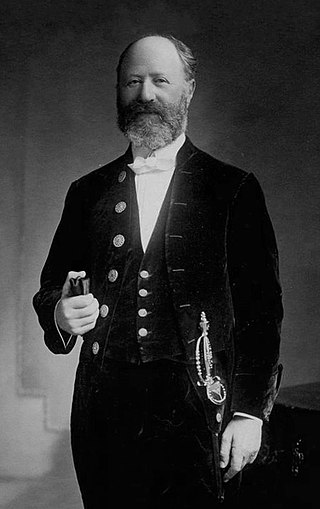Related Research Articles

Bletchley Park is an English country house and estate in Bletchley, Milton Keynes (Buckinghamshire), that became the principal centre of Allied code-breaking during the Second World War. The mansion was constructed during the years following 1883 for the financier and politician Herbert Leon in the Victorian Gothic, Tudor and Dutch Baroque styles, on the site of older buildings of the same name.

Irving John Good was a British mathematician who worked as a cryptologist at Bletchley Park with Alan Turing. After the Second World War, Good continued to work with Turing on the design of computers and Bayesian statistics at the University of Manchester. Good moved to the United States where he was a professor at Virginia Tech.
In cryptanalysis, gardening is the act of encouraging a target to use known plaintext in an encrypted message. It was a term used at the British Government Code and Cypher School at Bletchley Park, England, during World War II, for schemes to entice the Germans to include particular words, which the British called "cribs", in their encrypted messages. This term presumably came from RAF minelaying missions, or "gardening" sorties. "Gardening" was standard RAF slang for sowing mines in rivers, ports and oceans from low heights, possibly because each sea area around the European coasts was given a code-name of flowers or vegetables.
Alfred Dillwyn "Dilly" Knox, CMG was a British classics scholar and papyrologist at King's College, Cambridge and a codebreaker. As a member of the Room 40 codebreaking unit he helped decrypt the Zimmermann Telegram which brought the USA into the First World War. He then joined the Government Code and Cypher School (GC&CS).

Colonel Donald John Dean was an English recipient of the Victoria Cross, the highest and most prestigious award for gallantry in the face of the enemy that can be awarded to British and Commonwealth forces.

Sir Francis Harry Hinsley, was an English intelligence officer and historian. He worked at Bletchley Park during the Second World War and wrote widely on the history of international relations and British Intelligence during the Second World War. He was known as Harry Hinsley.
HMS Whitshed (D77/I77) was an Admiralty modified W-class destroyer of the Royal Navy. She was ordered from Swan Hunter & Wigham Richardson Ltd under the 14th Order for Destroyers in the Emergency War Program of 1918–19. She was the first ship to carry the name.

Maksymilian Ciężki was the head of the Polish Cipher Bureau's German section (BS–4) in the 1930s, during which time—from December 1932—the Bureau decrypted German Enigma messages.

Simon Jonathan Sebag Montefiore is a British historian, television presenter and author of history books and novels, including Stalin: The Court of the Red Tsar (2003), Jerusalem: The Biography (2011), The Romanovs 1613–1918 (2016), and The World: A Family History of Humanity (2022).
John William Jamieson Herivel was a British science historian and World War II codebreaker at Bletchley Park.

Reservehandverfahren (RHV) was a German Naval World War II hand-cipher system used as a backup method when no working Enigma machine was available.

Hugh William Montefiore was an English Anglican bishop and academic, who served as Bishop of Kingston from 1970 to 1978 and Bishop of Birmingham from 1978 to 1987.

Rolf Noskwith was a British businessman who during the Second World War worked under Alan Turing as a cryptographer at the Bletchley Park British military base.

Sir Herbert Samuel Leon, 1st Baronet was an English financier and Liberal Party politician, now best known as the main figure in the development of the Bletchley Park estate in Buckinghamshire.
Mavis Lilian Batey, MBE, was a British code-breaker during World War II. She was one of the leading female codebreakers at Bletchley Park.

Sir Moses Haim Montefiore, 1st Baronet, was a British financier and banker, activist, philanthropist and Sheriff of London. Born to an Italian Sephardic Jewish family based in London, after he achieved success, he donated large sums of money to promote industry, business, economic development, education and health among the Jewish community in the Levant. He founded Mishkenot Sha'ananim in 1860, the first Jewish settlement outside the Old City of Jerusalem.
Adam S. Montefiore is a British-born Israeli wine trade veteran, wine critic, wine writer and author.
Sir Joseph Sebag-Montefiore was a British banker, stockbroker and politician.
Thomas Ralph Erskine CB was a senior Northern Ireland government lawyer and historian of wartime codebreaking.
Action This Day was a 1941 memorandum sent to Winston Churchill personally, to advise Churchill that the Bletchley Park (BP) codebreaking establishment was short of staff in some critical areas. Their requirements were small, but as a small organisation their management did not have priority. Four senior heads of sections ("Huts") and their deputies wrote to Churchill, who had visited "BP" on 6 September 1941, where he made a speech saying he appreciated their work.
References
- ↑ "Hugh Sebag-Montefiore books and biography". Waterstones . Retrieved 3 September 2018.
- ↑ "The historians' letter to the BBC Trust", The Guardian , 2 October 2007
- ↑ Hitchens, Christopher (26 January 2007). "Review: Hugh Sebag-Montefiore's "Dunkirk"". International Herald Tribune . Retrieved 13 December 2017– via The New York Times.
The author's own cousin, Denzil Sebag-Montefiore, may have been one of the few Jewish platoon commanders on those gruesome beaches...
- ↑ Descendants of Jacob Lumbrozzo de Mattos (PDF), The Baruch Lousadas and the Barrows, p. 29, retrieved 19 May 2024
- ↑ Thomson, Ian (4 July 2016). "Somme: Into the Breach by Hugh Sebag-Montefiore review". The Observer . Retrieved 14 December 2017.
The author's own great-grandfather, Cecil Sebag-Montefiore, we learn, killed himself after serving with the Royal Engineers on the western front.
- ↑ "Sir Moses Montefiore, Baronet | British philanthropist". Encyclopedia Britannica. Retrieved 3 September 2018.
- ↑ "MONTEFIORE - JewishEncyclopedia.com". www.jewishencyclopedia.com. Retrieved 3 September 2018.
- ↑ Koch, James V. (May 2009), Definitely a Fight, But Not to the Last Man (review of Hugh Sebag-Montefiore, Dunkirk: Fight to the Last Man), H-Net: H-German Reviews